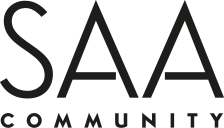
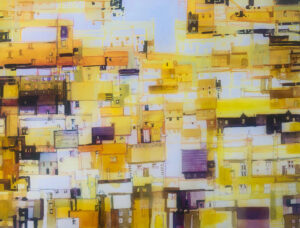 If you find that you are falling into the pattern of simply copying photographs and don’t feel you are creating anything original, then you might want to consider ‘Art Mining’. This odd-sounding term intends to impart the idea that, like a gold prospector, you keep digging at a potentially rich artistic seam until you ‘strike it lucky’ by creating new, interesting and even potentially valuable work. I have also seen the term used in the context of scouring the internet to find abundant and useful resources for an art project. The same notion of dig, dig, dig applies to both interpretations of the term. A few months ago, I was trying to impart the ‘Art mining’ ethos to some of my students through the following project. I ‘dug up’ an old demonstration piece I had completed as part of a course I ran on abstraction at Higham Hall, a residential, educational provider in the Lake District. In this semiabstract acrylic (main image), I first explored using horizontal and vertical lines of paint in varying widths, then added flat squares and oblongs to make a reasonably cohesive abstract image. Then, by adding flat-looking building details using pencil and paint, the picture transformed into a ‘modernistic’ painting of buildings on a hillside with a look of gritty, grimy industrialisation. This form of picture-making seemed to me to have the potential to be a fun idea to explore with limited art experience because it did not require a high level of drawing or painting skill, so it could be attempted and enjoyed by all. Most importantly, it did not rely on copying photographic references, so it could show one of the many ways artwork can be made outside the ‘norm’ of copying.
If you find that you are falling into the pattern of simply copying photographs and don’t feel you are creating anything original, then you might want to consider ‘Art Mining’. This odd-sounding term intends to impart the idea that, like a gold prospector, you keep digging at a potentially rich artistic seam until you ‘strike it lucky’ by creating new, interesting and even potentially valuable work. I have also seen the term used in the context of scouring the internet to find abundant and useful resources for an art project. The same notion of dig, dig, dig applies to both interpretations of the term. A few months ago, I was trying to impart the ‘Art mining’ ethos to some of my students through the following project. I ‘dug up’ an old demonstration piece I had completed as part of a course I ran on abstraction at Higham Hall, a residential, educational provider in the Lake District. In this semiabstract acrylic (main image), I first explored using horizontal and vertical lines of paint in varying widths, then added flat squares and oblongs to make a reasonably cohesive abstract image. Then, by adding flat-looking building details using pencil and paint, the picture transformed into a ‘modernistic’ painting of buildings on a hillside with a look of gritty, grimy industrialisation. This form of picture-making seemed to me to have the potential to be a fun idea to explore with limited art experience because it did not require a high level of drawing or painting skill, so it could be attempted and enjoyed by all. Most importantly, it did not rely on copying photographic references, so it could show one of the many ways artwork can be made outside the ‘norm’ of copying.
Art mining is not always about the results. It’s sometimes a way of organising your thoughts and ideas. Like the miner digging in the dark, you might not always follow a straight path. You might feel that treasure lies off in another direction, down a new tunnel. Your instincts might be correct in helping you find gleaming artistic nuggets. If, however, there turns out to be no obvious treasure down this new tunnel, you might need to find your way back to the original shaft so you don’t become lost. Then, you can re-work the first seam, which may yet prove to gleam with gold.
Once an artist has a theme to explore, the experienced ones use every kind of reference they can dig up that might help shape their art. While my students were creating the semi-abstract building pictures, I first showed them the obvious helpful images of old photographs of industrial towns,hilltop and fishing villages, and – to help them think in a more abstract sense – oil paintings by Mondrian. But, to cast the net wider, I then showed them architecture by Hundertwasser, a rich array of crafts with buildings as a theme and, of course, children’s book illustrations. All too often, art students only look at past artworks and photographs. It’s a rich and varied world out there, with
many visual treasures to offer the painter if they are open to new ideas. The students I worked with indicated that they had gained a better understanding of how an artist might approach a subject and work a theme over and over until their initial ideas begin to take form and feel more personal and ‘valuable.’ Some took the art mining notion into their own work and spent time expanding their reference material to aid in the process of making new work, and kept re-working their picturemaking methods until they had moved them on successfully. I found it fascinating to watch this happening. Many professional artists like to put over the idea that they work intuitively and that their art flows easily and naturally. This is generally hype to promote sales. If we were able to follow any painter’s art production, image by image, unedited, I am certain that we would quickly see that they have re-worked ideas over and over until they look polished and vibrant. If we could follow their reference searches they would most likely show a regular refresh to prevent their work from becoming stale. For those of you who wish to champion copying as the core of making art, I say this: Copying is an essential process to build up your technical skill, planning abilities, reflection on progress and process, and, of course, very importantly, a feeling of achievement and recognition of progress made. Art is, however, about more than copying. It’s about constructing images, objects or ‘events’ that reflect our views and feelings on the world around us. It’s occasionally possible to do that through copying alone, but not often. To build another level of sophistication within your work, I believe art mining is an essential process because it’s a personal process where you have to begin to step out on your own, make your own decisions without others there always to guide you. In other words, it’s part of maturing artistically. I could have chosen any subject – fish, faces or fruit, for example. I just happened to choose buildings. Your art mining project could tackle any subject or style that interests you. What I have shown is just one tiny glimpse into this process. The following step by step will help anyone who is interested in how I made the houses images.
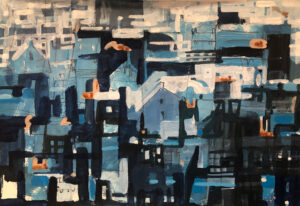 Note how the number of recognisable building shapes is not high. Building forms are hinted at but not explained so that the image looks semi-abstract and, to some degree, mysterious.
Note how the number of recognisable building shapes is not high. Building forms are hinted at but not explained so that the image looks semi-abstract and, to some degree, mysterious.
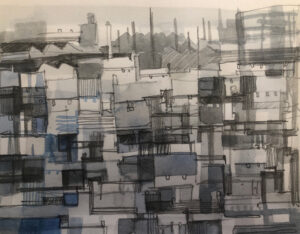 The students were given a photocopy of the painting and asked to make their own interpretation of the work after being shown the basic principles of construction using liquid graphite, pencil, and a little watercolour. Seen here is my demonstration piece. I asked them to try very hard not to copy the acrylic painting image in their own drawings but to see the reference only as a helpful starting point for their own work.
The students were given a photocopy of the painting and asked to make their own interpretation of the work after being shown the basic principles of construction using liquid graphite, pencil, and a little watercolour. Seen here is my demonstration piece. I asked them to try very hard not to copy the acrylic painting image in their own drawings but to see the reference only as a helpful starting point for their own work.
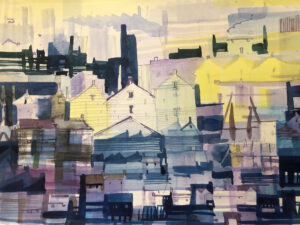 From this drawing study, they then explored using pencil with coloured inks, making a new picture working from their first drawn experiments. I once again demonstrated this in the artwork seen here. The idea of this exercise was to let the learners play with the image construction a little more and begin to feel more confident with the methodology.
From this drawing study, they then explored using pencil with coloured inks, making a new picture working from their first drawn experiments. I once again demonstrated this in the artwork seen here. The idea of this exercise was to let the learners play with the image construction a little more and begin to feel more confident with the methodology.
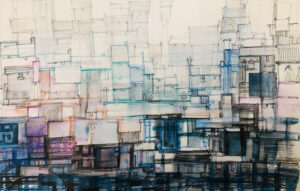 To continue to show how you might ‘art mine’ the initial methods, I shifted mediums again, this time using watercolour pencils. In this version, I wanted to move away from a dirty industrial look and hint at the look of an old historic town. It was a subtle shift, but enough to change the feel of the image to something a little lighter in touch. This image, I feel, has a more storybook feel.
To continue to show how you might ‘art mine’ the initial methods, I shifted mediums again, this time using watercolour pencils. In this version, I wanted to move away from a dirty industrial look and hint at the look of an old historic town. It was a subtle shift, but enough to change the feel of the image to something a little lighter in touch. This image, I feel, has a more storybook feel.
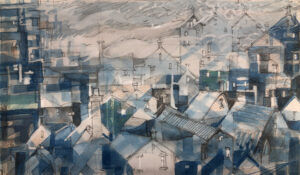 I then began to think of a fishing village, this time experimenting a little with adding small touches of perspective and white lines that add the look of water floating across the buildings to make it dreamlike. This image is less cohesive than the others, but perhaps it points towards new picture ideas where fish, water, waves, and even boats could be added as new motifs in a coastal offshoot of my original notion.
I then began to think of a fishing village, this time experimenting a little with adding small touches of perspective and white lines that add the look of water floating across the buildings to make it dreamlike. This image is less cohesive than the others, but perhaps it points towards new picture ideas where fish, water, waves, and even boats could be added as new motifs in a coastal offshoot of my original notion.
Want to keep reading? This article is exclusive to SAA members, where you’ll also enjoy a wide range of benefits, including:
Unlock these perks and more by joining today! Become a member.
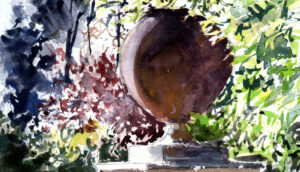
VideoItalian Urn in watercolour with Jason Skill |
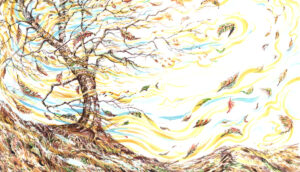
BlogHow to Compose your Painting with Jason Skill |
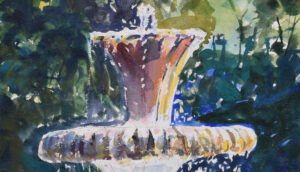
VideoFountain in mixed media with Jason Skill |
This article is for members only. Please login or sign up to continue reading.
Notifications